

Curation by Louise Jackson. Definition of curator in English by Lexico Dictionaries. Noun 1A keeper or custodian of a museum or other collection.
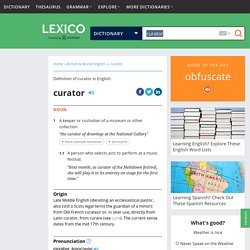
‘the curator of drawings at the National Gallery’‘Unlike many museum exhibitions, the curators provided the information to the viewer in manageable pieces.’ ‘The sale had been eagerly anticipated by collectors and museum curators.’ ‘The noise and lights derive not from history, but from the present manipulations of Imperial War Museum curators.’
‘The artists are up-and-comers and players in the Sydney art scene and the curators are museum big wigs and people in the know.’ As definition of 'curator' evolves, traditional curation still crucial for games. The word "curate" is thrown around a lot lately, especially since Valve Software deemed its 100 million users "curators.
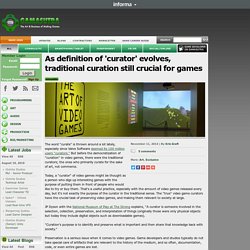
" But before the democratization of "curation" in video games, there were the traditional curators; the ones who primarily curate for the sake of art, not commerce. Today, a "curator" of video games might be thought as a person who digs up interesting games with the purpose of putting them in front of people who would like to try or buy them. Everyone’s a Curator. That’s Not (Always) a Bad Thing. Osman Can Yerebakan expresses a similarly open-minded approach.
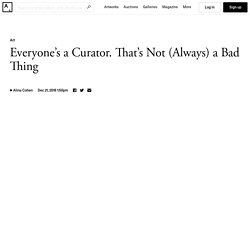
An art writer who holds an MA degree in fine and studio arts management (not curatorial studies), he’s also organized shows at the Queens Museum and the Center for Book Arts, and expresses a similarly open-minded approach. “It’s not law, it’s not science, it’s not medicine,” he said. It’s not about the technical know-how needed to sell a company or conduct a blood transfusion—curating is about having “a certain way of being able to see things that’s different, or being able to see connections” between artworks. Francisco Correa Cordero—who runs the Tribeca gallery Lubov, works as executive coordinator at Independent Curators International (ICI), and serves as a “guest curator” for Foundwork (a new online platform for emerging artists)—began his career studying photography and studio art.
Calling himself a curator, he now helps artists realize new projects and organizes public programs. But where do you draw the line? Content curation: overview, benefits, goals and tools. One of the hot topics in content marketing is content curation.

9 Awesome Benefits of Curating Content. Curating content is a popular, powerful strategy for improving your content marketing.

When you think of curating content, it’s no surprise if some of the most successful sites on the web come to mind. In its heyday, for example, Upworthy was perhaps the biggest and most trafficked site around almost solely dedicated to curation, racking up millions of monthly hits. What is curation? Well, the term curation comes from the world of museums. In theory, the curator is the person responsible for selecting certain artifacts, organizing them in a certain way, and thus creating an experience where everything relates to a particular theme.
Online curators do much the same thing, but without the archaeology degree. When you curate online, you look for the best content for your audience. The end result: Your audience gets to see some of the best stuff around related to their specific interests. But, why should you choose content creation when you could handcraft amazing content? 1. 2. 3. 4. 5. 6. 7. Steps to successful content curation – source. Pearltrees. Pearltrees refers to itself as "a place for your interests".[7] Functionally the product is a visual and collaborative curation tool[8][9][10][11] that allows users to organize, explore and share any URL they find online as well as to upload personal photos, files and notes.[12] The product features a unique visual interface[13][14] that allows users to drag and organize collected URLs, and other digital objects.[15] that themselves can be further organized into collections and sub-collections,[16] (URLs).
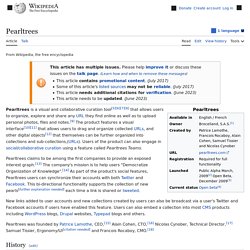
Users of the product can also engage in social/collaborative curation using a feature called Pearltrees Teams.[17] Pearltrees was founded by Patrice Lamothe, CEO,[21] Alain Cohen, CTO,[22] Nicolas Cynober, Technical Director,[23] Samuel Tissier, Ergonomy/UI[24] and Francois Rocaboy, CMO.[25] History[edit] Development of Pearltrees began in 2007. In July 2012, Pearltrees launched their iPhone app. Pearltrees introduced Pearltrees 2.0 on May 22, 2014. Usage[edit] Privacy[edit] Pearltrees Radically Redesigns Its Online Curation Service To Reach A Wider Audience. Pearltrees, the Paris-based online curation service that launched in late 2009, was always known for its rather quirky Flash-based interface that allowed you to organize web bookmarks, photos, text snippets and documents into a mindmap-like structure.

For users who got that metaphor, it was a very powerful service, but its interface also presented a barrier to entry for new users. Today, the company is launching a radical redesign that does away with most of the old baggage of Pearltrees 1.0. Gone are the Flash dependency, the tree diagrams, the little round pearls that represented your content and most everything else from the old interface. Here is what Pearltrees 1.0 looked like: Pearltrees releases a new version, without any pearls nor trees. The Paris-based startup founded in 2009 once declared: “We focus on the visual potential of Pearltrees to let people dive deeply into their interests and nearly feel them”.
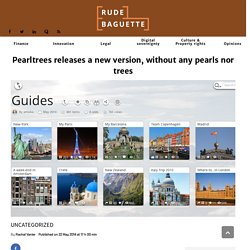
How to use pearl trees.